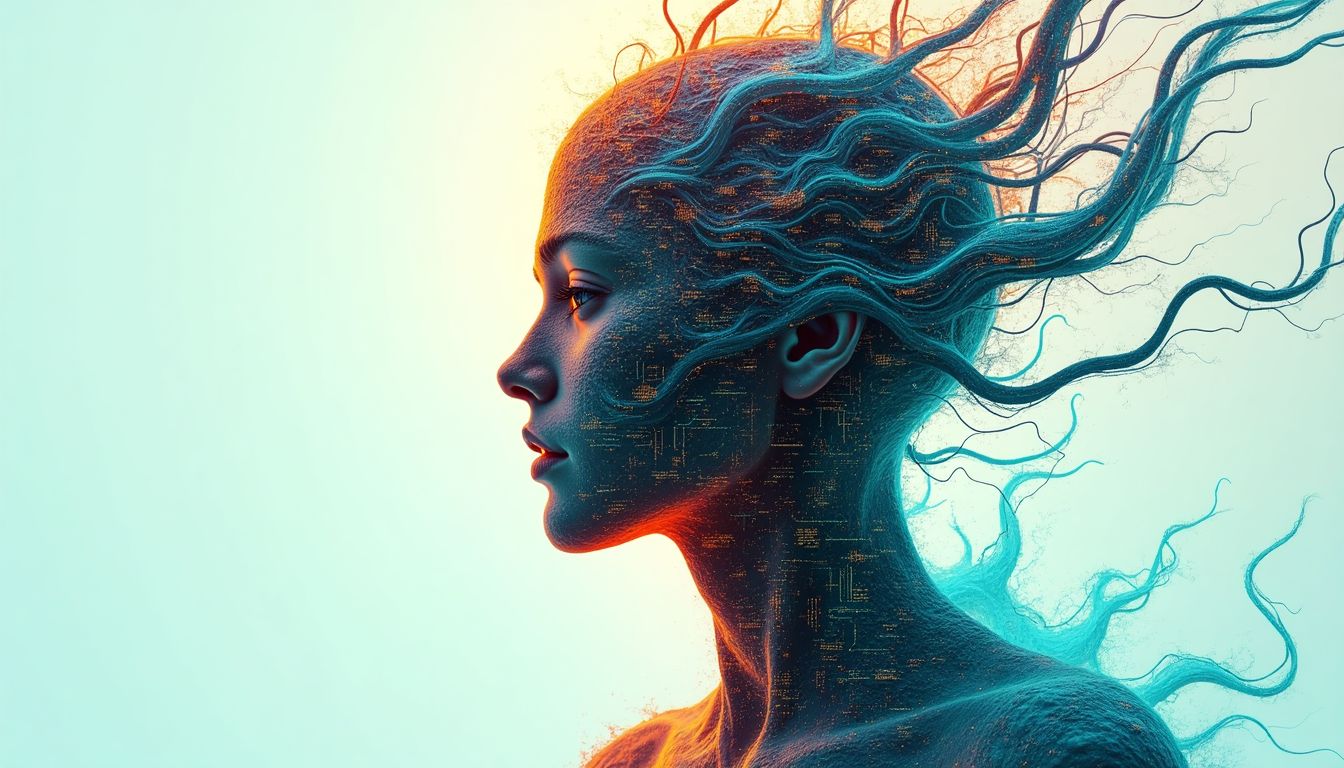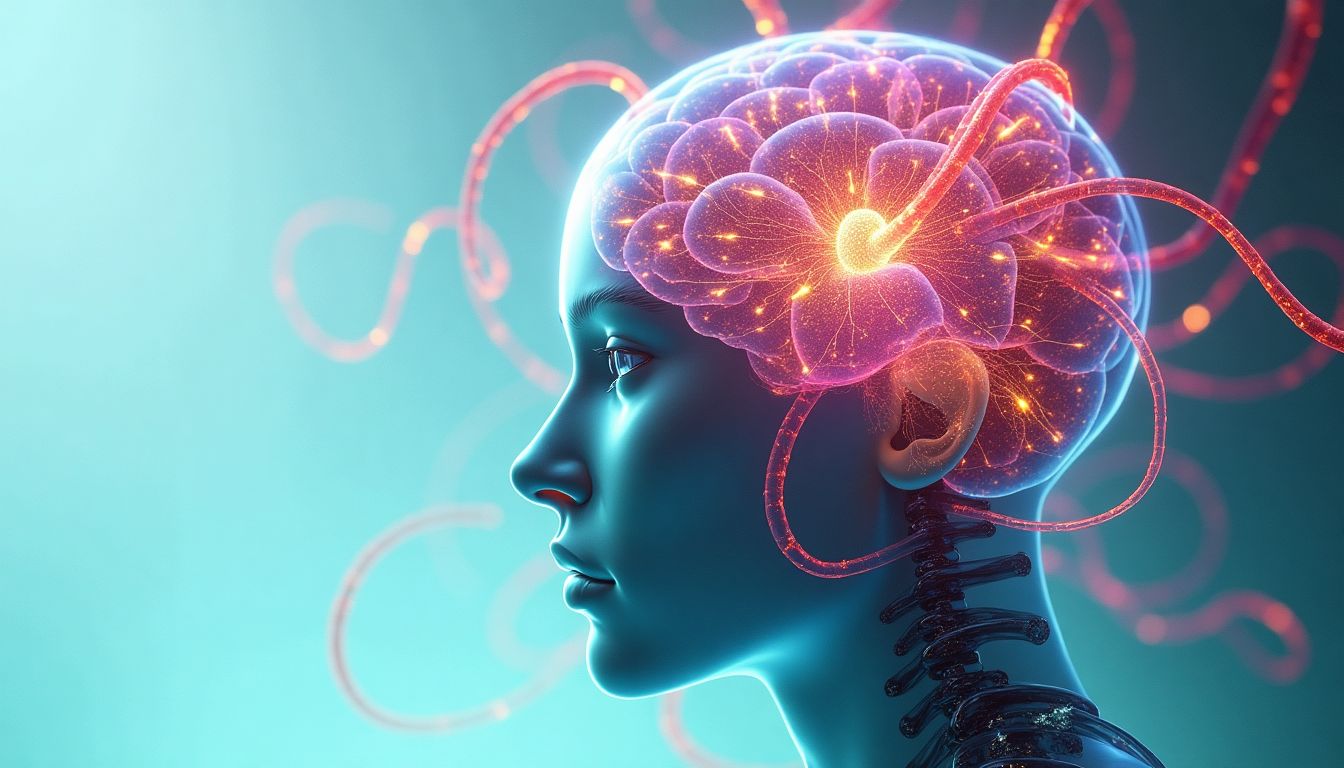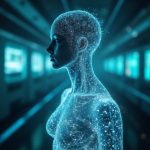Introduction: Crafting Bodies for Digital Souls
The ultimate revelation is that consciousness can be separated from the body. We might just be ghosts in this machine. This thought-provoking idea raises questions about the very essence of our identity. As we journey further into the realms of science and technology, concepts once tucked away in the pages of science fiction have begun to claw their way into reality. The merging of mind uploading and genetic engineering could enable us to inhabit new, organic vessels while leaving behind the limits of our biological confines. Imagine waking up in a fresh, younger body—goodbye back pain and hello youthful exuberance! Who wouldn't want a permanent upgrade?
So here’s a bouncer of a question: What if the key to eternal life doesn't involve magic or mystical incantations, but rather a digitized mind housed in a genetically crafted body? As we stand at the edge of technological possibility, the intersection of artificial intelligence, consciousness, and biology prompts us to rethink existence itself. Renowned thinkers like Ray Kurzweil, Hans Rosling, and Kevin Warwick delve into the concepts of AI and consciousness, challenging us to ponder the future of humanity.
1. The Science of Mind Uploading
Delving into mind uploading feels like diving into a sci-fi novel that’s taken an unexpected turn toward reality. So, what’s the science behind this fascinating idea? In simple terms, mind uploading is a way to transfer our thoughts and experiences into a digital format. But how does that work, you ask? It begins by exploring the very essence of what makes us… well, us!
1.1 The Neural Basis of Consciousness
Scientists have tackled the elusive question of consciousness for decades. It’s like trying to catch smoke with your bare hands—tricky, to say the least. Current theories propose that consciousness is not a magical spirit but rather an intricate web of neural activity in our brains. Renowned neurologists and cognitive scientists are continually attempting to decipher this web, revealing how neurons communicate and create our sense of self. Are we an elaborate puppet show put on by our brain's firing neurons? Maybe! But as we understand more about this neural activity, the dream of capturing our conscious essence becomes more tangible.
1.2 Technological Framework for Uploading
As we’ve discovered, understanding consciousness is just one part of mind uploading; we also need technological innovations that would allow us to digitize our minds. Enter cutting-edge technologies like neural mapping, data storing techniques, and digital substrates. Imagine high-tech brain-scanning devices piecing together the puzzle of your memories like a sophisticated jigsaw! And with advancements in AI and data analytics, we’re getting closer every day to creating that digital twin—a mind that can live on, free from the physical realm.
2. Genetic Engineering: Crafting Organic Bodies
As we dive deeper into our digital future, we have an exciting playground called genetic engineering. This is where scientists are using cutting-edge techniques to manipulate the very building blocks of life itself. Imagine having the power to edit genes like a text document! In this section, we will giggle our way through the tools of genetic engineering that could help us create new, organic bodies perfectly suited for our digital comrades.
2.1 Advances in CRISPR and Gene Editing
One of the most talked-about tools in the genetic engineering toolbox is CRISPR-Cas9. This fancy name refers to a method that allows scientists to edit genes with unmatched precision. Basically, it's like a pair of high-tech scissors that snips out parts of DNA and replaces them with new and improved codes. Thanks to organizations like the NIH, we’re learning how to manipulate genes to create bodies with specific traits—think strength, longevity, or perhaps even a little extra charm! But wait, before we start giving superpowers to everyone, let’s remember the ethical questions lurking in the shadows, like a monster under the bed.
2.2 Biofabrication and Organ Growth
Have you ever dreamed of ordering your very own organ online? Well, thanks to biofabrication, that dream is getting closer to reality! Scientists are engineering living tissues using 3D bioprinting technology that layers bioinks—living cells—into the shape of an organ. Cornell University researchers are leading the charge in exploring how these bio-printed organs can be used for transplants. It's like ordering a pizza but instead of pepperoni, you get a brand-new heart! However, let’s not forget the cautionary tales of adding too many toppings. This is a new frontier where science fiction is colliding with reality, and we need to tread carefully!
3. Ethical Considerations of Mind Uploading
The conversation around mind uploading isn’t just about how we can do it; it’s also about whether we should do it. Diving headfirst into a digital pool without checking for shallow water is never a good idea! Here, we’ll tackle some of the big ethical questions that pop up when we think about transferring our consciousness into new bodies.
3.1 Questions of Identity and Continuity
If we upload our minds, will we still be “us”? Imagine transitioning from your humble, organic self into a powerhouse of fiber optic brilliance. But who are you when you’re living in a new body? Some argue that the new digital self wouldn’t hold the same identity, while others say your experiences and memories will keep you whole. Think of it this way: If you were a tree, cutting off your leaves might change your appearance, but you’d still be rooted in the same soil. TED Talks have plenty of fascinating content on this topic that amply illustrates the dilemma of identity and continuity.
3.2 The Societal Impact of Enhanced Beings
Let’s ponder a situation: what happens in a world where some people can upload their minds and have shiny new bodies while others can't? Suddenly, we could find ourselves divided into “upgraded” and “non-upgraded” versions of humanity. Talk about the ultimate class divide! This raises big questions about access to technology. Will those with deep pockets leave the rest of us to ride the digital bus while they cruise in their self-driving Ferraris? Preparing for these societal shifts is like organizing a tedious family reunion—we can't just ignore the potential for drama!
4. Psychological Implications
As we imagine a world where our minds could be uploaded to new bodies, we must also consider the psychological effects of such a radical change. How would our mental health and sense of identity be impacted? What challenges would we face as we adjust to this unprecedented way of living? Exploring these questions reveals a complex landscape where the digital and physical merge, affecting our very essence.
4.1 Adaptation of Digital Consciousness
Making the leap from a biological body to a new, possibly synthetic one could be daunting. Imagine waking up one day and having a completely different physical form—it sounds like something out of a science fiction movie, right? But science is starting to inch closer to making this a reality.
How might we adapt? Here are a few potential scenarios:
- Self-Perception Changes: Our view of ourselves might shift. If what we see in the mirror no longer matches our mental image, how do we feel about who we are? It could lead to identity crises.
- Physical Capabilities vs. Mental Expectations: We may have a stronger or weaker body, which can change how we engage with the world. Graphic athlete and filmmaker Adam Scott uses his experience to discuss how body image impacts confidence and mentality.
- Emotional Resilience: Some may need therapy or support systems to cope with this transition. Adjusting to the idea of living in a different body might require mental health care tailored for digital beings.
4.2 The Role of Memory and Experience
Memory plays a crucial role in shaping who we are. As we embark on this journey of consciousness transfer, we must ask how our ability to retrieve and create memories will change. Will the new body store our memories the same way? Let's explore some possibilities:
| Aspect | Current Understanding | Potential Changes |
|---|---|---|
| Memory Retrieval | Memories are complex and tied to sensory experiences in our bodies. | New bodies might alter how we retrieve or access these memories. |
| Experience Substitution | Our experiences shape who we are. | Digital consciousness in a new body may have to learn to adapt to different experiences altogether. |
| Emotional Connection | Memories evoke strong emotions that form our identity. | The way a new body interacts with the environment might create different emotional responses. |
5. Future Societies: Living with Digital Souls
As we think about a future where digital consciousness exists alongside traditional human life, we need to look at how societies may change. What laws, cultures, and beliefs will shape a world inhabited by both living beings and digital souls? This scenario pushes us to expand our understanding of community, identity, and rights.
5.1 Legal Rights of Digital Souls
The conversation around rights for digital beings will undoubtedly grow louder. How do we ensure that someone with a digital consciousness is treated fairly and equitably? Here are some considerations:
- Legal Personhood: Should digital souls qualify for the same rights as living humans? Should they have the right to own property, vote, or enter into contracts? Imagine the debate:
- Protection Against Exploitation: Lawmakers might need to prevent corporations from taking advantage of digital beings, in the same way we strive to protect vulnerable populations today.
- Dispute Resolution: Courts will require new frameworks to handle conflicts between digital beings and humans, as well as among digital beings.
5.2 Implications for Religion and Philosophy
This new world will also challenge the very fabric of various belief systems. How will religions respond to the concept of digital souls? Here are some potential shifts we might see:
- Spiritual Interpretations: Many religions may need to reexamine their teachings about the soul, life after death, and the meaning of existence.
- New Philosophical Questions: Thinkers will debate concepts of consciousness, identity, and morality in ways we can only begin to imagine.
- Religion in a Digital Age: Faith communities may adapt their practices for those navigating digital identities, creating inclusive spaces for digital beings.
6. AI Solutions: How would AI tackle this issue?
To tackle the complex issue of crafting new bodies for digital souls, AI can play an intricate role in multiple stages of the process. From developing effective algorithms for data mapping of neural networks to optimizing biological growth conditions, AI can systematically address the challenges inherent in both mind uploading and genetic engineering.
6.1 AI-Driven Neural Mapping
Creating accurate digital representations of human consciousness requires advanced neural mapping tools. AI can develop algorithms that learn from existing neural data, making the mapping process more precise over time. Techniques like machine learning can be employed to analyze firing patterns of neurons, enabling a complete digital reconstruction of a mind.
6.2 Predictive Modeling for Genetic Engineering
Employing AI to predict the outcomes of genetic modifications can greatly enhance research by providing probable success rates and potential complications based on historical genetic studies. By using AI, scientists can simulate the effects of different genetic changes, facilitating the design of bodies optimized for hosting digital consciousness.
6.3 Ethical AI Frameworks
As we navigate uncharted territories, AI can assist in ethical decision-making frameworks to ensure that mind uploading is not only effective but also morally sound. Developing standards and protocols for the responsible use of these technologies will become critical. By using machine learning algorithms to evaluate outcomes and societal impacts, AI can help ensure safe advancements.
Actions Schedule/Roadmap (Day 1 to Year 2)
- Day 1: Assemble a diverse team of neurologists, geneticists, AI developers, ethicists, and bioengineers from institutions like
MIT and
Stanford to foster interdisciplinary collaboration. - Day 2: Conduct a comprehensive literature review on existing technologies, focusing on mind uploading and genetic engineering trends.
- Day 3: Establish partnerships with leading universities such as
Harvard or
Caltech, specializing in AI and biotechnology, to share knowledge and resources. - Week 1: Develop a detailed project proposal outlining objectives, methodologies, and expected outcomes for the interdisciplinary team.
- Week 2: Initiate funding applications to secure capital for research and development, targeting private investors and government grants.
- Week 3: Develop collaborative agreements with commercial partners in bioengineering and data science, ensuring equitable resource-sharing.
- Month 1: Finalize a technology review, identifying gaps in current capabilities that the project aims to fill, aided by AI tools for data analysis.
- Month 2: Begin preliminary experiments on neural data mapping using AI algorithms for sensitive data extraction and processing.
- Month 3: Conduct a series of ethical analyses and surveys to gauge public opinion on mind uploading and genetic modification technologies.
- Year 1: Initiate extensive trials in mind uploading and body engineering, while continuously assessing ethical implications through AI-driven feedback mechanisms.
- Year 1.5: Evaluate overall project progress; establish transparency practices by sharing interim results with stakeholders and regulatory bodies.
- Year 2: Present findings at scientific conferences, engage with regulatory agencies, and prepare for potential regulatory approvals for real-world applications of these innovations.
Conclusion: Merging Minds and Machines—The Frontier Ahead
As we dance on the edge of technology and humanity, the marriage of mind uploading and genetic engineering stands to redefine our very essence. Imagine a world where one's consciousness can transcend the burdens of biology, crafting new, enhanced physical forms that align better with our aspirations and dreams. Yet with this bold new territory comes responsibility and ethical considerations that we must navigate carefully. Each step we take in this exploration could illuminate the depth of our identity, the complexity of our existence, and the profound connections we share as humans. What rights will digital entities possess? How will cultures adapt to this new reality? Only time will tell, but the choices we make today will echo through generations. As we stand before this brave new world, it is our duty to question the velocity of technological advancement and its implications on our understanding of life and legacy. What does it mean to be human when the line between biology and technology fades? Can our digital souls peacefully coexist with our organic origins? This is the transformative era that beckons for thoughtful discussion and spirited debate. Together, let us forge a path that honors our humanity while embracing the dazzling possibilities of the future.
FAQ
- What is mind uploading?
- Mind uploading is the theoretical process of transferring a person's thoughts, memories, and personality from their brain into a digital format. This could allow a person's consciousness to exist without needing a physical brain. Imagine preserving your friend's essence in a computer!
- Can consciousness really exist outside of a biological body?
- Right now, scientists don't have a clear answer to this question. Research in neuroscience and cognitive science, organizations like National Institute of Mental Health, explores how our minds work, but there’s still a lot we don’t understand about consciousness. It’s like trying to solve a mystery with missing pieces.
- What ethical concerns surround mind uploading?
- When we talk about mind uploading, many ethical questions pop up. Here are some big ones to think about:
- Who owns the digital copy of your consciousness?
- Will it still be "you," or just a copy?
- Could this technology create unfair advantages for those who can afford it?
- How does genetic engineering contribute to this process?
- Genetic engineering can help create new bodies that might be able to host digital consciousness. Scientists can manipulate genes to make bodies with special features. For instance, researchers at the Jackson Laboratory work on genetic models that could lead to significant breakthroughs. It's like customizing an action figure to make it just the way you want!
- What role does AI play in mind uploading and genetic engineering?
- Artificial Intelligence (AI) can play a big part in both mind uploading and genetic engineering. Here’s how:
- Data Mapping: AI can help create accurate digital maps of our brains, which is super important for mind uploading.
- Predictive Modeling: In genetic engineering, AI can predict how changes to DNA will affect a living organism, helping scientists make informed decisions.
- Ethics Support: AI can help researchers navigate the tricky ethical questions surrounding these groundbreaking technologies.
- Could mind uploading change personal identity?
- This is a hot topic for debate! If you upload your mind, some argue that it might not be the "real" you anymore, and you could lose important aspects of your identity. Like when you change pieces of art—does it still have the same meaning? As writers, philosophers, and ethicists discuss these questions, it’s critical for all of us to think about what makes us who we are.
- How do societies adapt to the idea of digital souls?
- As the idea of digital souls becomes more real, societies will need to adapt. Legal frameworks, social norms, and even belief systems will evolve. For example, what rights would a digital soul have? What role will religion play if we live in a world where minds can inhabit new bodies? Groups like the American Association for the Advancement of Science can help explore these complex questions.
- Is there a timeline for when mind uploading or genetic engineering will be possible?
- It's difficult to say for sure! Many scientists believe that these technologies could be possible within the next few decades, but it depends on breakthroughs in research and addressing ethical concerns. It’s kind of like waiting for your favorite new video game to come out—it could be next year or maybe even in a few years!
Wait! There's more...check out our gripping short story that continues the journey: The Nexus
Disclaimer: This article may contain affiliate links. If you click on these links and make a purchase, we may receive a commission at no additional cost to you. Our recommendations and reviews are always independent and objective, aiming to provide you with the best information and resources.
Get Exclusive Stories, Photos, Art & Offers - Subscribe Today!





























Post Comment
You must be logged in to post a comment.